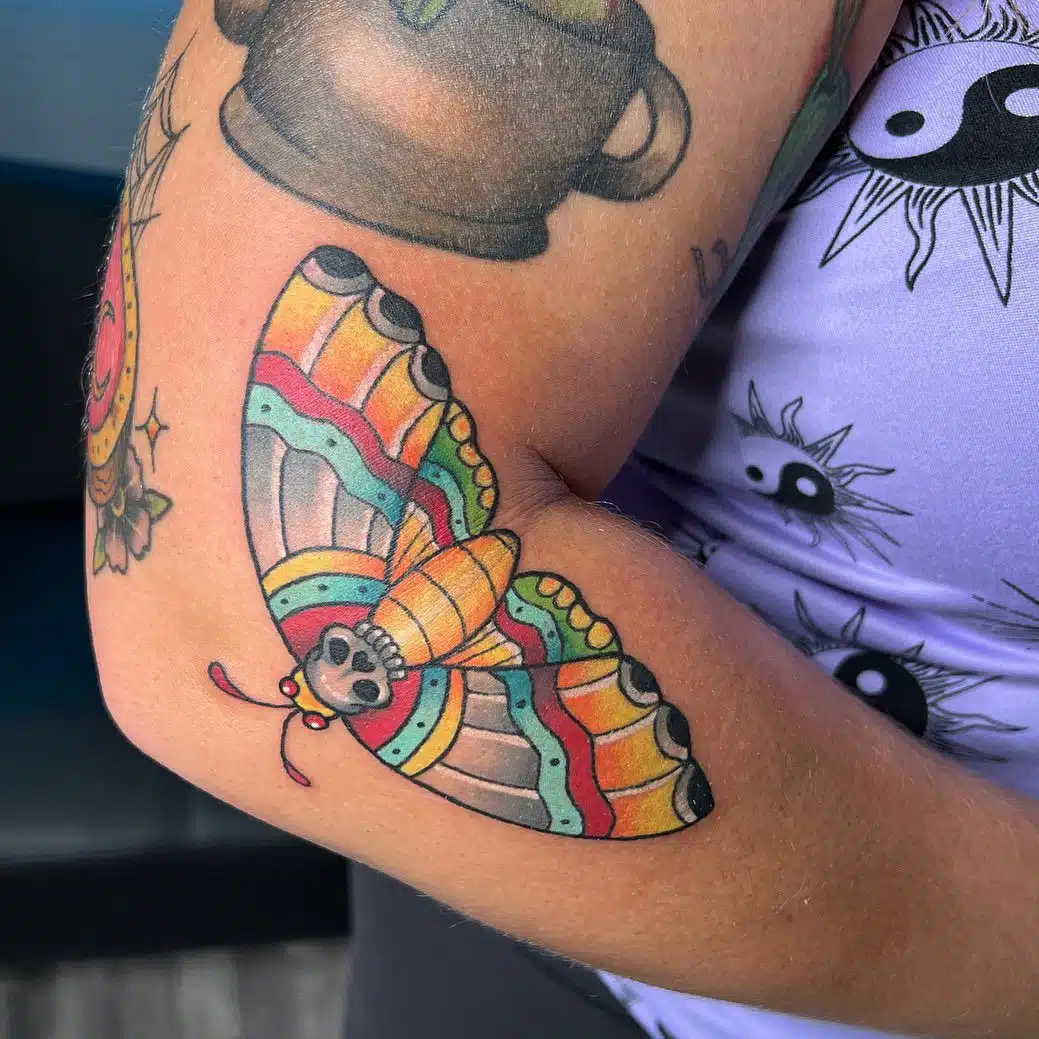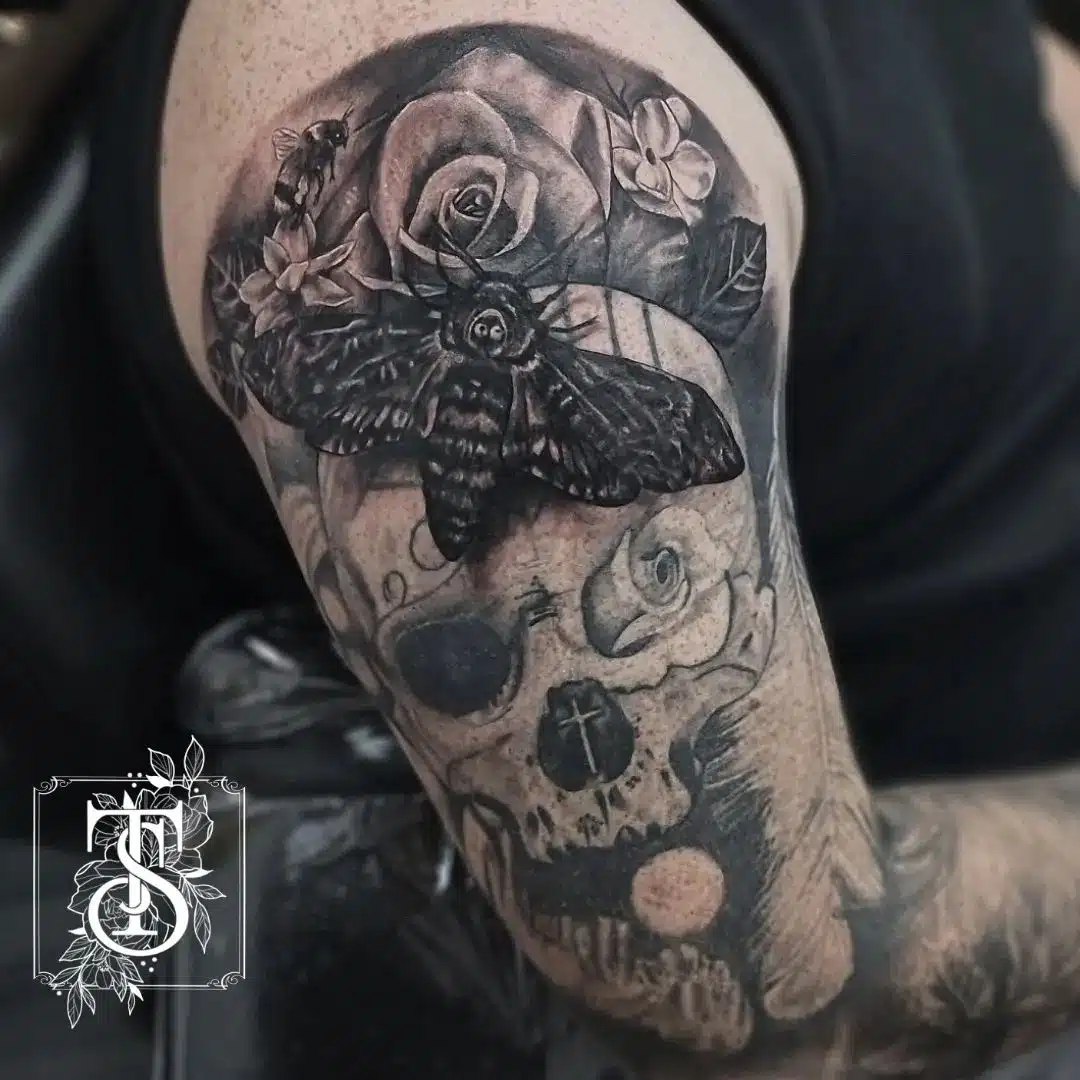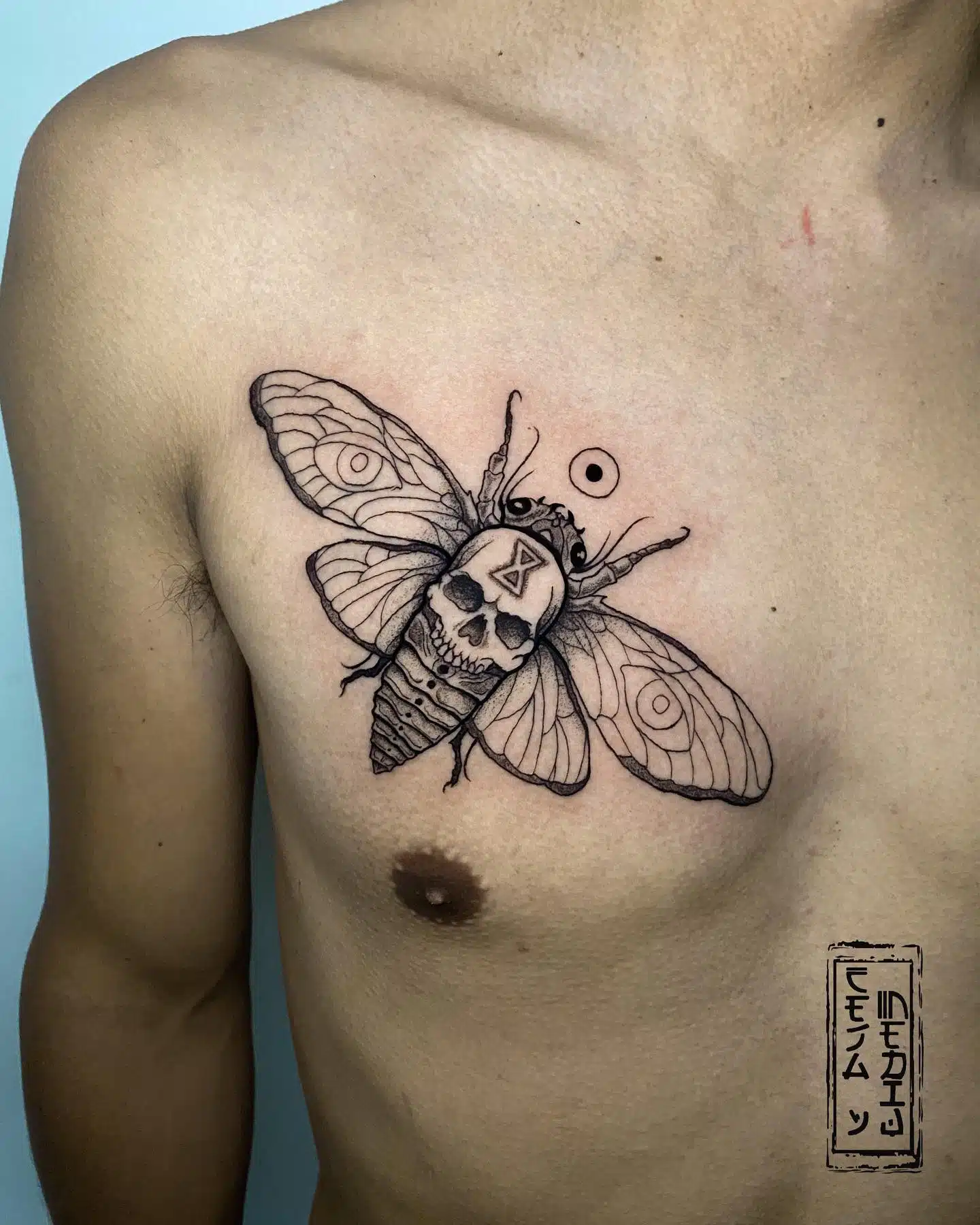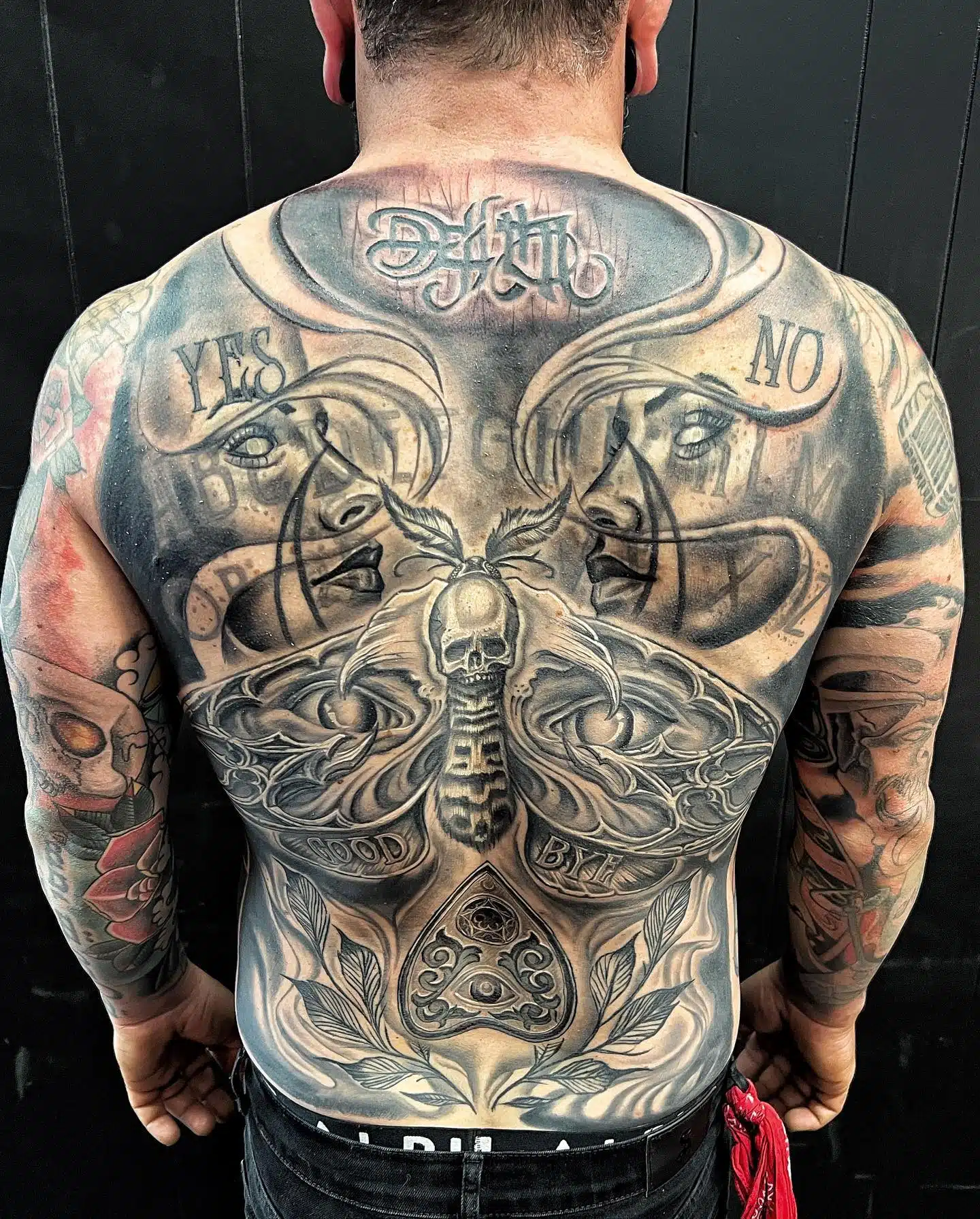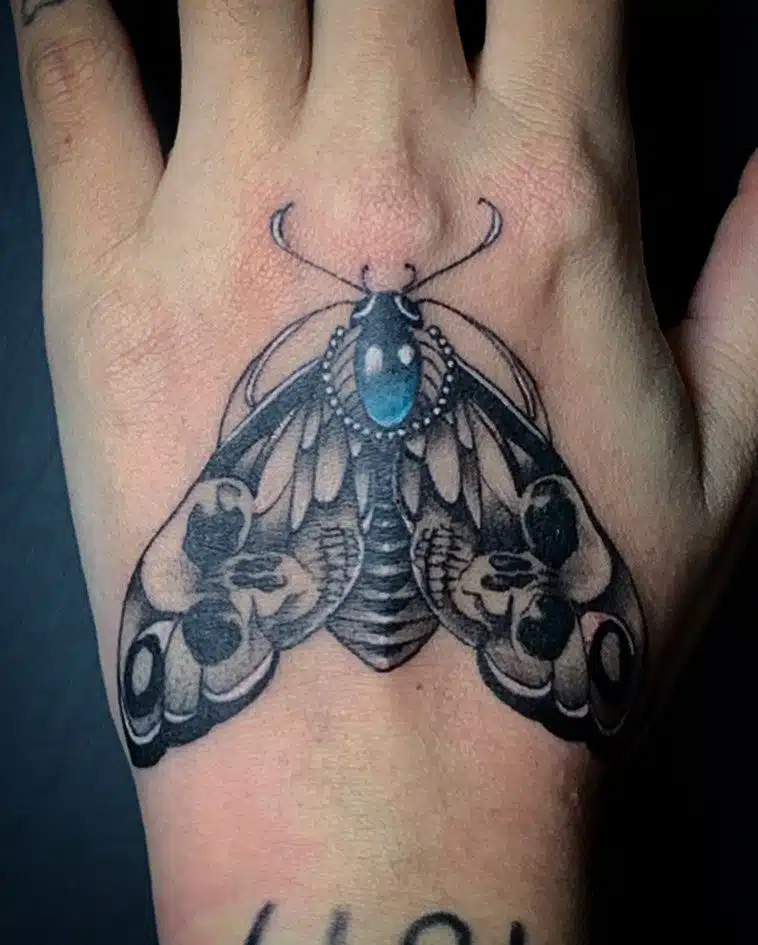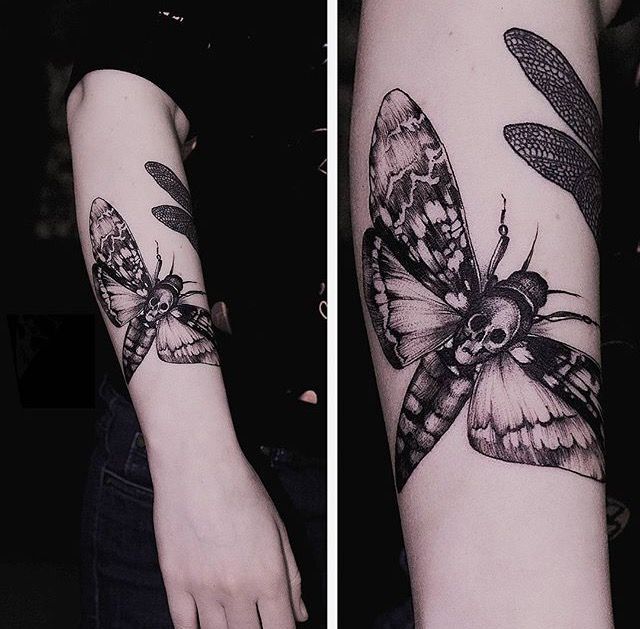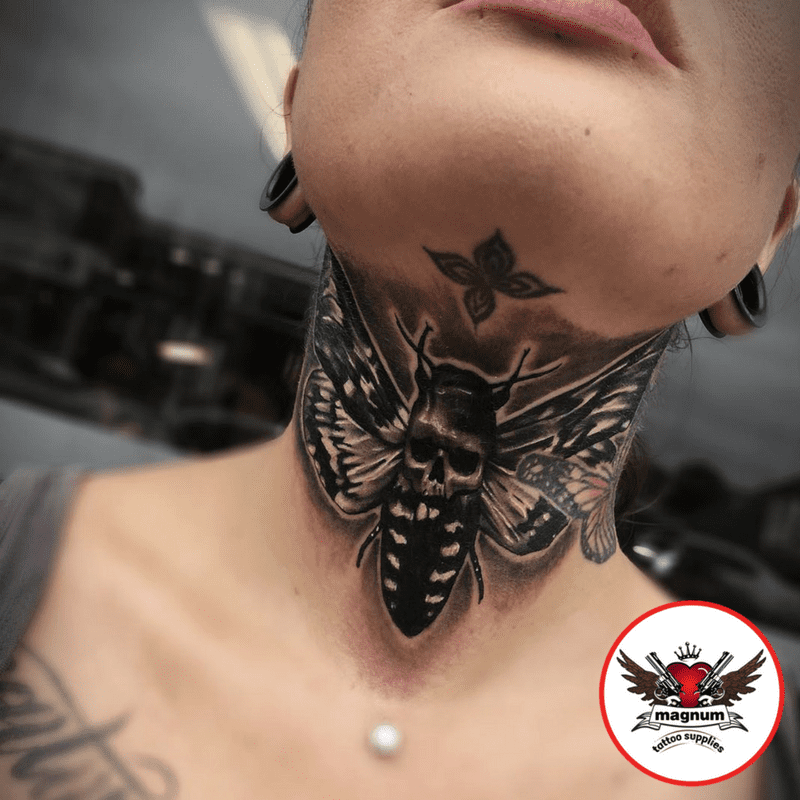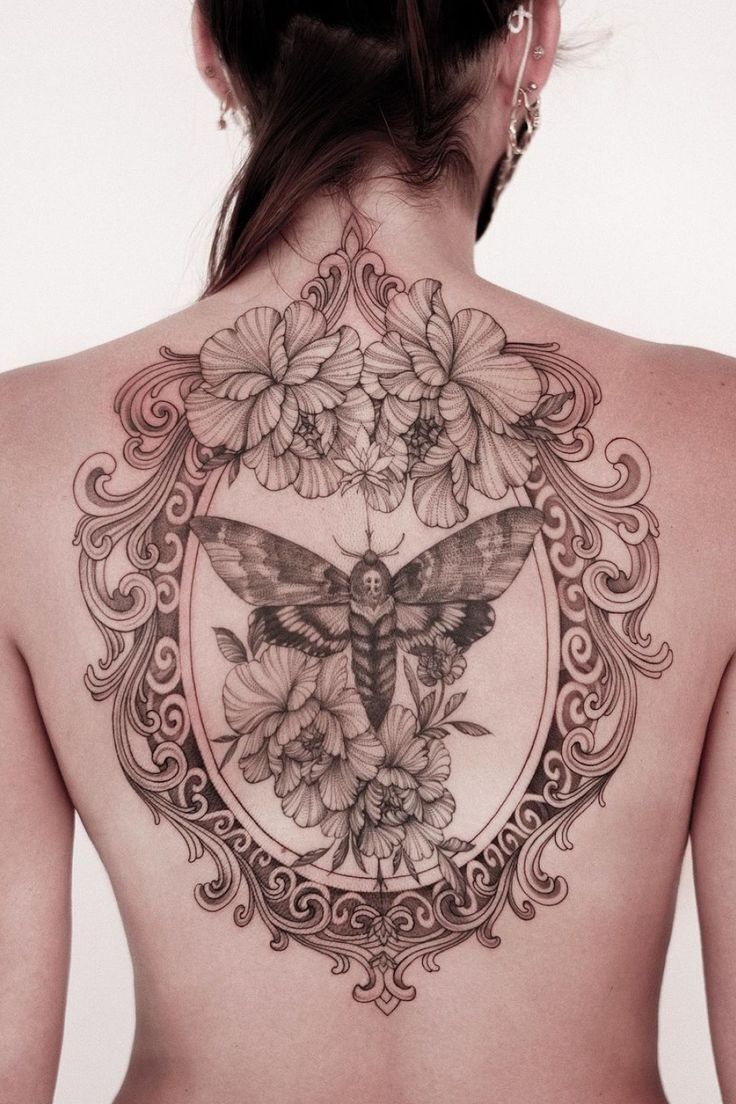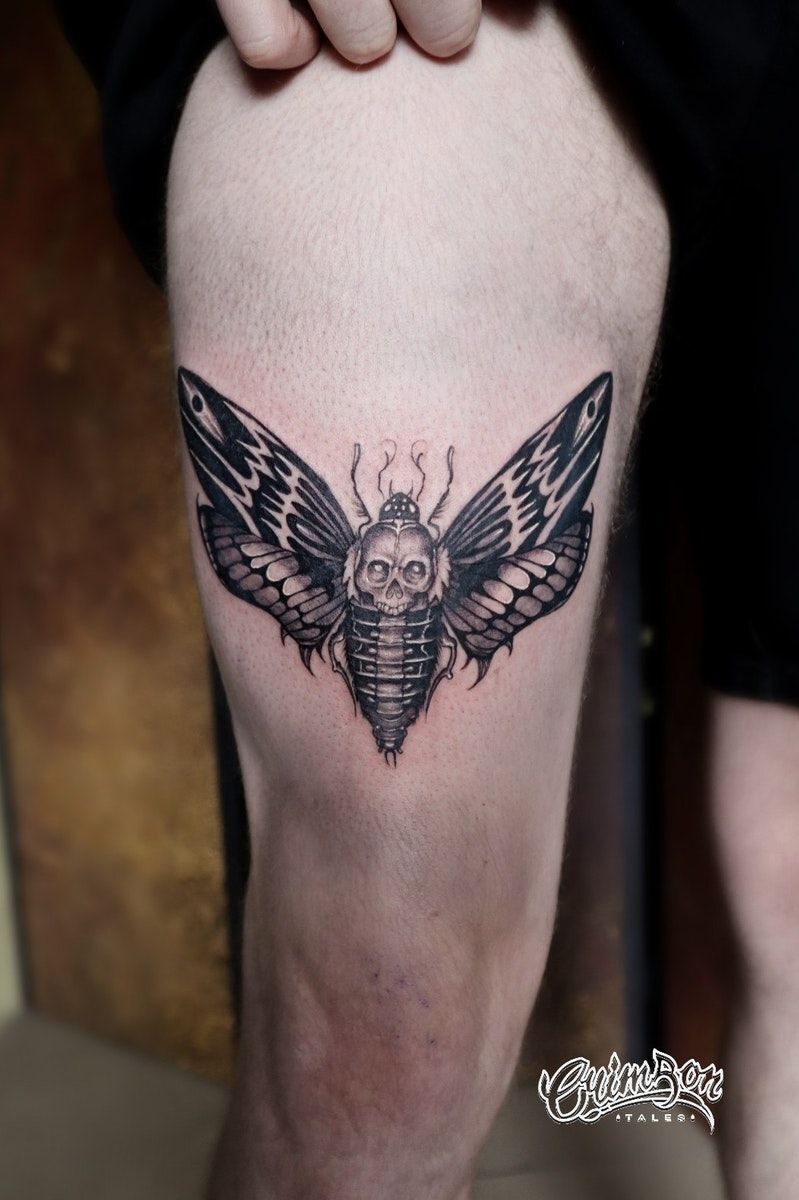Step into the realm where darkness and artistry intertwine, beckoning you to explore the depths of your soul. If you yearn for a tattoo that encapsulates the mystique of mortality and the allure of transformation, then prepare to be enthralled by the captivating world of Death Moth designs.
In this gripping article, we delve into the psychological intrigue behind these inked masterpieces, igniting your curiosity and urging you to scroll down to discover the mesmerizing allure of embracing the darkside like never before. Unleash your inner rebel and let the Death Moth guide you on a journey of inked expression that defies convention.
Are you only interested in tattoo designs and want to skip the educational part?
No problem, we got you covered! Click HERE to get inspired.
What does the death moth symbolize?
The Death's Head Hawkmoth, commonly referred to as the Death Moth, holds symbolic significance in various cultures and contexts. Here are a few interpretations associated with the symbol:
Mortality and Death: The Death Moth is often seen as a representation of mortality and the inevitability of death. Its ominous appearance and skull-like pattern on its thorax have made it a popular symbol in art, literature, and tattoo designs.
Transience and Impermanence: The moth's relatively short lifespan and nocturnal nature have led to associations with the transient nature of life and the concept of impermanence. It serves as a reminder of the fleeting and fragile aspects of existence.
Transformation and Rebirth: Moths, in general, are associated with transformation due to their life cycle, starting as caterpillars, undergoing metamorphosis, and emerging as adult moths. The Death Moth's symbolism may also encompass themes of change, rebirth, and the cyclical nature of life.
Spiritual or Supernatural Significance: Some interpret the Death Moth as a symbol with spiritual or supernatural connotations. It has been linked to mysticism, occultism, and the realm of the afterlife in certain belief systems.
Rebellion and Nonconformity: The image of the Death Moth has been embraced by counterculture movements and individuals seeking to express nonconformity. Its association with death and dark aesthetics can symbolize a rejection of societal norms or a statement of individuality.
What Does a Death Moth Tattoo Mean?
The death moth tattoo is a popular choice for those looking to express their dark side. The tattoo mostly features a black moth with large wings and prominent antennae, often surrounded by flames, adding to the ominous look of the tattoo. While the death moth tattoo can be interpreted in many ways, it is often seen as a symbol of death or destruction.
In some cultures, moths are associated with bad luck, and the death moth tattoo can be seen as a way of embracing this darkness. For others, the moth tattoos represent simply a way of expressing their love of all things dark and morbid. Whatever the meaning behind it, the death moth tattoo is sure to turn heads and make a statement.
best Death Moth Tattoo Designs And Their Meanings
While the death moth tattoo is a popular choice, there are a few common death moth tattoo ideas and designs that are seen more often than others. These designs often feature the moth in different settings or with different elements added to them.
Rainbow Dead Moth Tattoo
One of the most beautiful death moth tattoo designs features a rainbow-colored death moth. This design is a combination of good and bad, positive and negative, or even life and death. The moth represents the transition from one stage to another, so in terms of insect tattoos, this means that the person who wears this tattoo enjoys not only the good side of life but accepts the bad parts of it as well.
Skull Rose Dead Moth Tattoo
Another popular death moth tattoo design features a skull in the center of the moth, surrounded by roses. This tattoo can symbolize both death and beauty, representing the delicate balance between the two. It can also be seen as a reminder that life is fleeting and to make the most of every moment.
The meaning of this tattoo will be different for everyone, but it is a powerful and unique design that is sure to turn heads. It is also a great choice for those who want a tattoo that is both dark and romantic. The placement of this dagger tattoo is also very versatile, as it can look great on the arm, leg, back, or even the chest. This popular tattoo moth idea is perfect for both men and women.
Hourglass Dead Moth Tattoo
This tattoo design features an hourglass above the skull head. The tattoo can represent both the shortness of life and the inevitability of death. It is a reminder that life is precious and should be enjoyed while it lasts. It can also be seen as a warning to others not to take life for granted.
Visionary Dead Moth Tattoo
This is one of the most popular moth tattoos, and it is often associated with death. The visionary dead moth tattoo is a symbol of change and choices. This tattoo can also represent transition, transformation, and rebirth.
The dead moth is often seen as a negative omen, but it can also be seen as a positive sign of change. If you are considering getting this tattoo, make sure you understand the meaning and symbolism behind it. Because the meaning of this tattoo is so personal, it is often seen on the chest or back.
Jeweled Dead Moth Tattoo
Like most moth tattoos, the jeweled death moth tattoo can also be seen as a reminder that change is inevitable. No matter how much we may want things to stay the same, they will always eventually change. And while some changes may be sad or difficult, ultimately, change is a natural and necessary part of life. It is what keeps us moving forward and helps us to grow and learn.
So, when you see someone with a jeweled death moth tattoo meanings, know that they are not only beautiful but also wise beyond their years. It is a tattoo that is sure to start a conversation and leave a lasting impression.
Most common death moth tattoo placements and their pain levels
When it comes to tattoo placements, the preference varies from person to person. However, I can provide you with some common placements for a death moth tattoo along with a general idea of their pain levels. It's important to note that pain tolerance varies among individuals, so these pain levels are subjective and can differ from person to person.
Arm death moth tattoo
The arm is a popular placement for tattoos due to its visibility and versatility. Death moth tattoos on the upper arm, forearm, or bicep are common choices. The pain level in this area is generally moderate, as the skin is relatively fleshy and there is a decent
Throat Death Moth Tattoo
Throat tattoos can be quite striking and bold, but they are also considered one of the more painful areas to get tattooed. The skin on the throat is thin and sensitive, and there are numerous nerve endings present. As a result, the pain level for a death moth tattoo on the throat is typically high.
chest Death Moth Tattoo
The chest is a popular choice for larger tattoos, including death moth designs. Pain levels for chest tattoos can vary depending on the specific area and the person's body composition. The tattooing process can be more uncomfortable near the sternum and collarbone due to proximity to bone and thinner skin. Generally, the pain level for a death moth tattoo on the chest can range from moderate to high.
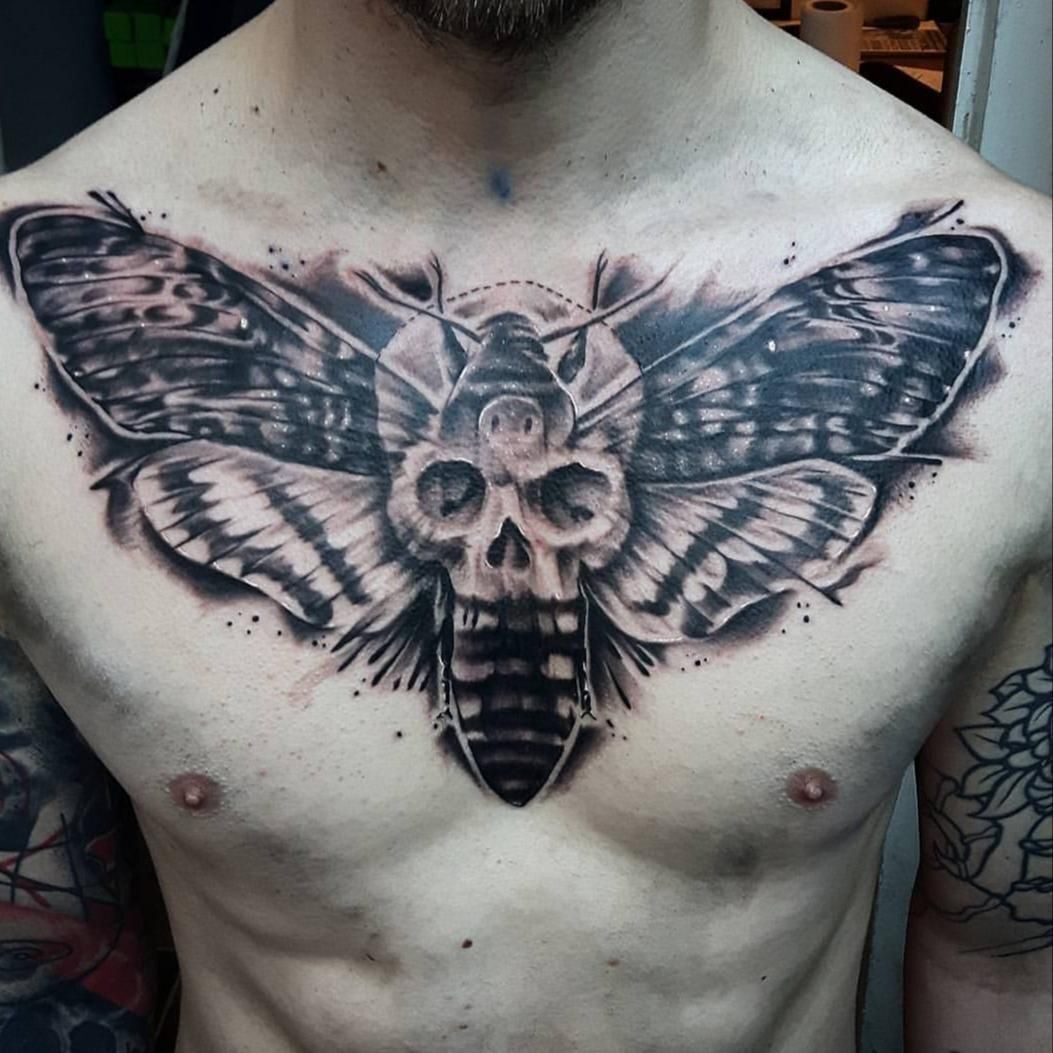
back Death Moth Tattoo
The back offers a large canvas for tattoo placement, making it a common choice for expansive designs like death moth tattoos. Pain levels on the back are often moderate, although some areas closer to the spine or the shoulder blades may be more sensitive. The pain can also vary depending on the person's tolerance and the intricacy of the design.
Thigh Death Moth Tattoo
Thigh tattoos, whether on the front or the back, are favored by many people. They can be easily hidden or shown off depending on clothing choices. Pain levels for thigh tattoos are generally moderate, as the area has a good amount of flesh and muscle to cushion the sensation. However, tattooing closer to the inner thigh or near the knee might be more sensitive.
General Breakdown Of Tattoo Pain Levels On Different Body Parts
Here is a breakdown of the different tattoo pain levels:
- Low: This level of pain is generally described as a mild discomfort or tickling sensation. It is similar to the sensation of getting a light scratch or scrape.
- Moderate: This level of pain is generally described as a moderate discomfort or aching sensation. It is similar to the sensation of getting a deep scratch or scrape or being pinched.
- High: This level of pain is generally described as a strong discomfort or throbbing sensation. It is similar to the sensation of getting a burn or being stung by a bee.
It's important to note that pain tolerance is highly individual and can vary greatly from person to person. Some people may find certain body parts more or less painful than others, and the same body part can be more or less painful for different people. Additionally, the level of pain can be affected by factors such as the size and location of the tattoo, the skill of the tattoo artist, and the individual's own pain threshold.
Tattoo placement pain level chart
Body Part | Pain Level | Explanation |
Forehead | Low | The forehead has few nerve endings, so it is not a particularly painful area. |
Eyebrows | Low | The eyebrows have few nerve endings, so the pain level is relatively low. |
Ear | Low | The ear is a relatively thin and fleshy area, so the pain level is low. |
Nostril | Low | The nostril is a small area with thin skin, so the pain level is low. |
Lip | Low to Moderate | The lip has more nerve endings than some other areas, so it may be slightly more painful. |
Cheek | Low to Moderate | The cheek has a moderate amount of nerve endings, so it may be slightly more painful. |
Moderate | The neck has a moderate amount of nerve endings, so it may be slightly more painful. | |
Chest | Moderate to High | The chest has a high concentration of nerve endings, so it can be quite painful. |
Abdomen | High | The abdomen has a high concentration of nerve endings, so it can be quite painful. |
Back | High | The back has a high concentration of nerve endings, so it can be quite painful. |
Shoulders | High | The shoulders have a high concentration of nerve endings, so they can be quite painful. |
Upper Arms | Moderate to High | The upper arms have a moderate to high concentration of nerve endings, so they can be somewhat painful. |
Elbows | High | The elbows have a high concentration of nerve endings, so they can be quite painful. |
Forearms | Moderate | The forearms have a moderate concentration of nerve endings, so they are not as painful as some other areas. |
Hands | High | The hands have a high concentration of nerve endings, so they can be quite painful. |
Lower Arms | Low to Moderate | The lower arms have a lower concentration of nerve endings, so they are not as painful as some other areas. |
Wrists | Low | The wrists have a low concentration of nerve endings, so they are not very painful. |
Lower Back | High | The lower back has a high concentration of nerve endings, so it can be quite painful. |
Buttocks | High | The buttocks have a high concentration of nerve endings, so they can be quite painful. |
Thighs | High | The thighs have a high concentration of nerve endings, so they can be quite painful. |
Knees | High | The knees have a high concentration of nerve endings, so they can be quite painful. |
Calves | Low to Moderate | The calves have a low to moderate concentration of nerve endings, so they are not as painful as some other areas. |
Ankles | Low | The ankles have a low concentration of nerve endings, so they are not very painful. |
Tattoo aftercare tips
Before getting a tattoo:
Choose a reputable tattoo artist and parlor. Research the artist's portfolio and read reviews from previous clients.
Consult with the artist about the design and placement of the tattoo.
Make sure you are in good health. If you have any medical conditions or are taking any medications that may affect your ability to heal, be sure to let your tattoo artist know.
Consider using a numbing cream to reduce pain during the tattooing process. These creams contain a numbing agent (such as lidocaine) that can be applied to the skin before the tattoo is done. It's important to follow the instructions on the numbing cream and to only use it as directed.
Avoid alcohol, caffeine, and other substances that can thin your blood for at least 24 hours before getting a tattoo.
Eat a healthy meal before your tattoo session to ensure that your blood sugar is stable.
Wear loose, comfortable clothing that allows easy access to the area being tattooed.
After getting a tattoo:
Follow the aftercare instructions provided by your tattoo artist. These may include:
Keeping the tattoo clean and covered with a bandage for the first few hours after getting tattooed.
Washing the tattoo with lukewarm water and a mild soap (such as unscented, antimicrobial soap) and patting it dry with a clean towel.
Applying a thin layer of tattoo ointment or lotion (such as A&D or Aquaphor) to the tattoo and covering it with a clean bandage or wrap.
Repeating this process for the first few days, or until the tattoo has fully scabbed over.
Avoid soaking the tattoo in water for the first week, such as in a bath or pool.
Avoid picking or scratching at the scabs, as this can cause the tattoo to fade or become infected.
Avoid exposure to direct sunlight or tanning beds for at least 2-4 weeks.
If you experience any redness, swelling, or unusual discharge, contact your tattoo artist or a healthcare professional.
Overall, it's important to keep your tattoo clean and moisturized during the healing process to ensure that it heals properly and looks its best. Using a numbing cream can help reduce pain during the tattooing process, but it's important to use it as directed and to follow all aftercare instructions to ensure that your tattoo heals properly.
Remember, these are just general guidelines, and pain tolerance can vary greatly from person to person. It's always a good idea to talk to your tattoo artist about your pain tolerance and any concerns about your tattoo's pain level.
@jordxn.nicole Hard work pays off 🙂 #fyp #fypシ #tattoo #dance ♬ original sound - Jordan Nicole
History and origin of the death moth tattoo
The death moth tattoo is a design that has been used in various cultures and art styles throughout history. The moth is a symbol associated with death and transformation in many different cultures, and it has been used to represent these themes in literature, art, and tattooing.
In European folklore, the death moth is often associated with the "death's-head hawk moth," a type of moth with a distinctive pattern on its thorax that resembles a human skull. This month has been a symbol of death and the afterlife in many cultures.
In Japanese culture, the death moth is often associated with the Mono no aware, which refers to the bittersweet feeling of being aware of the impermanence of things. In this context, the death moth is seen as a symbol of the fleeting nature of life and the inevitable cycle of death and rebirth.
Death moth tattoos have become increasingly popular in recent years, and they are often used to represent themes of transformation, impermanence, and the cycle of life. They can be designed in various styles, from traditional to modern, and can be incorporated into various tattoo styles.
The meaning of the death moth tattoo in different religions and cultures
The death moth tattoo is a symbol that has been used in various cultures and religions throughout history and has been associated with various meanings and themes. Here is a brief overview of the meaning of the death moth tattoo in some different religions and cultures:
Christianity: In some Christian traditions, the death moth symbolizes the soul and the transition from life to death. In this context, the death moth is often associated with themes of resurrection and the afterlife.
Buddhism: In Buddhist teachings, the death moth is often associated with impermanence, which is the idea that all things are constantly changing and that nothing lasts forever. In this context, the death moth is seen as a reminder of the fleeting nature of life and the importance of living in the present moment.
Japanese culture: In Japanese culture, the death moth is often associated with the concept of Mono no aware, which refers to the bittersweet feeling of being aware of the impermanence of things. In this context, the death moth is seen as a symbol of the fleeting nature of life and the inevitable cycle of death and rebirth.
Native American culture: In some Native American cultures, the death moth is seen as a symbol of transformation and rebirth. In this context, the death moth is often associated with shedding old skins and emerging as a new, transformed being.
It's important to note that the meanings and associations of the death moth tattoo can vary depending on the context and the individual's cultural and personal beliefs.
Watch A Time-Lapse Video Of A Death Moth Tattoo Done By A Pro:
175+ Death Moth Tattoo Ideas For Your Inspiration
Final Thoughts
Now that you know the meaning behind these popular death moth tattoo designs, it's time to choose one that speaks to you. Whether you're looking for a reminder of change or a symbol of death, there is a death moth tattoo out there that is perfect for you. So don't be afraid to express yourself with this unique and powerful ink. Be sure to do your research and find an experienced tattoo artist to bring your vision to life.

